Page 2
The Resilience of Plants: Opportunity
A Plant In a Strange Place
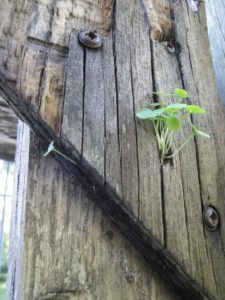
I enjoyed seeing this cluster of weeds growing in a tiny cavity of the garden fence. The wood is old and decaying, but a few seeds apparently blew into this space no larger than the head of a screw. Due to the very limited accommodations, the plants didn’t live long, withering a few days later.
Although they were short-lived, the little seedlings show the tendency of plants to explore their territory. It’s trial-and-error; sometimes the environment is conducive to growth and sometimes it isn’t. But because plants generally overproduce seeds, some are likely to land where conditions are appropriate for growth. This is how new land greens up, whether scarred from lava, landslide, fire, or flood. Seeds or rooted stems take hold, and they compete for water and nutrients. The ones best suited to the conditions at that time are those that might survive long enough to reproduce.
We’ve all seen weeds growing in a home’s neglected gutters. Fallen leaves gathered there for a season or longer, moistened by rain and decomposing over months of time. Birds and breeze deposit seeds, finding a rich substrate in which to grow. Then, during prolonged drought, it’s all over for these pioneers.
When I lived in Charlotte and traveled west toward Hendersonville, I often passed under an abandoned train trestle. Within the cracks and crevices, several tough-as-nails pine seedlings grew for many years. No additional water, other than rain and dew, and no fertilizer except for rotting vegetation and what passing birds left behind. And yet, those plants grew a couple of inches each year despite searing heat and winter exposure.
Young Lavender
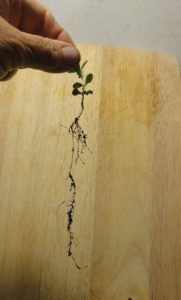
Lavender ‘Ellagance Purple’ seedling.
Here’s a young lavender ‘Ellagance Purple’ seedling, with surprisingly long roots. Native to the Mediterranean region, where it’s hot and dry much of the year, lavender must quickly grow deep roots to find water in order to survive challenging conditions. Seeds germinate with seasonal rains and later search for dampness held lower in the soil.
Lavender has silvery trichomes, as the air plants do (described below), to trap humidity near the leaf surface and to reflect the sun’s harsh glare.
Another Surprise Seedling
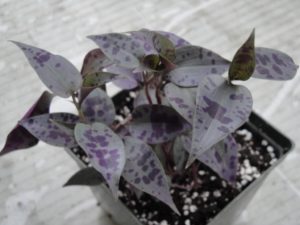
Tinantia pringlei, or Widow’s Tears, in 2011.
I’d been growing several of the tropical trailing Tradescantia (wandering Jew) species in the Maryland gardens, and thought this seedling was the result of a chance pairing of varieties. After doing some research, I learned it’s the spotted tradescantia (Tinantia pringlei), also called Widow’s Tears. I’d never seen the plant before and haven’t since then (other than those I grow), but one seed evidently landed in this pot of soil sitting near the garage. What are the chances?!
Since then, this plant, native to the mountains of northern Mexico, has seeded randomly in various places. It likes part sun or light shade. Near the tips of the 12″ stems grow pretty 3-petaled lavender-purple flowers typical of the Commelinaceae family, which includes the spiderworts and wandering Jew.
I’m not sure if Tinantia is hardy here in USDA zone 7, so I’m testing a few plants in the garden. Various websites indicate it’s hardy in zone 7 or 8 and south. (***Update***: A few plants are growing in the gardens, so it is hardy here. 4/22/2023)
The Resilience of Plants: Recovery
Cryptanthus
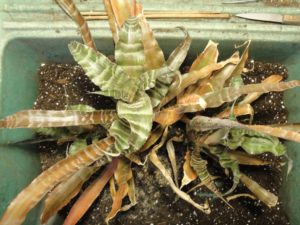
Cryptanthus is a genus of colorfully leaved terrestrial bromeliads (Bromeliaceae family). The term Cryptanthus means “hidden flower”; the plants do flower, but the blooms are small and sometimes hidden by the foliage. These Earth Stars are grown for their tough, often spiny-edged leaves. Foliage color can range from shades of green, gray, and brown to silver and black, to burgundy, bright pink, and red.
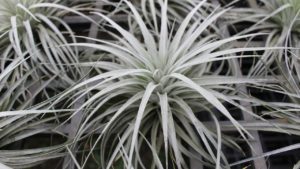
One of the Tillandsias, or air plants.
The variety in the photo above has deep olive-green leaves banded in silvery-green, with maroon undertones. I’ve been growing this variety for about 30 years. Leaves are dotted with scaly trichomes, which can absorb water and humidity from the air. But cryptanthus, being terrestrial, absorbs most of its water from the soil. Many other bromeliads absorb water from rain deposited in the central vase.
Perhaps you’re familiar with their cousins, the Tillandsia species, bromeliads whose silver trichomes completely cover their leaves. Tropical Tillandsias—the air plants—root in crevices of tree bark, but water absorption into the leaves is facilitated by their trichomes.
Propagating Bromeliads
One fact that gardeners learn about bromeliads, including pineapple, is that all that pretty foliage dies off every year or two. That’s their normal life cycle; they grow, bloom, and then die. But before they die, they grow new young plants, called pups or offsets, from the base of the plants.
As the parent plant dies a leaf at a time, I remove the brown leaves as they occur. Those pups gain strength from the sun and grow larger. Eventually, all the old foliage can be removed.
Once the pups are large enough to handle, they can be separated from the crown of the plant. From one original plant, you might be able to propagate several new plants.

First, remove all old foliage. Now, use a knife to cut between the pups, or gently pry them free. If all the roots break off, the offset might root if the base of the offset is intact. Nestle it into a small pot of damp (not wet) soil, and provide dappled sunlight and high humidity. In the photo, above, the pup is the short section in the center. Other pups were larger and had already been potted up (6 pots) when I took this photo.
Plant the offsets in small pots, 3-4″ in diameter. They rooted outdoors in early autumn of 2022. Then I moved them under artificial lights in the basement, where they’ve grown to a size large enough to sell at the farmers’ market this spring (photo, below).
The FCBS Bromeliad Database describes an incredible 500 species and cultivars of Cryptanthus.

Cryptanthus with new foliage, in 4 1/2″ pots.
The Petunia
- Petunia in mid-summer, not tended very well!
- A 10″ petunia basket, cut back hard.
Last spring, I bought a 10″ petunia hanging basket for its intriguing flower colors: shades of rich terra cotta with some purple on the margin. It was on sale for $6.00. The photo (above, left) shows that plant after months of neglect and overgrowth (uh… busy!).
It had flowered well enough through mid-summer, but by August, it was overdue for a cut. Normally, for petunias, I prune a couple of the longest stems every few weeks, almost down to the soil. In good sun and with a dose of fertilizer, dormant buds in the stumps grow into new leafy stems, which flower a few weeks later. This time, though, I cut back all the stems so no leaves remained. And I removed the one hot pink plant in the center.
It took a while for the petunia to leaf out and flower again, but it looked better than it did when purchased. I’m keeping it in the enclosed porch for the winter, although I did cut it back again. Petunias can be short-lived perennials where the weather suits them (freeze-free). It will probably survive, thanks to warmth from the Christmas lights, for another year on the deck.
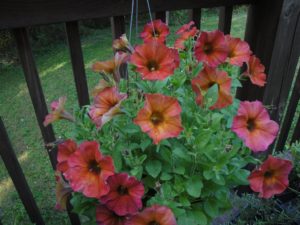
Fully recovered petunia.
Giant Redwoods Define the Resilience of Plants
These venerable giants can live for 1,800 to over 3,000 years of age. Fossil records indicate these species have existed for over 150 million years. They’ve survived frigid winters, hot summers, drought, and wildfires.
Heavy harvesting from 1850—during the early gold rush—through part of the 20th century wiped out most of the trees. To preserve the remaining old growth forests, organizations rallied to save them from destruction. Acreage was bought by state and federal park systems, while some is held privately. Currently, only 5% of old growth redwood forests survive compared to before 1850.
The term “Redwood” refers to 3 species of plants in the Cupressaceae family:
- The coastal redwoods, Sequoia sempervirens, the tallest trees, grow up to 380′ in height and 16-18′ DBH (diameter at breast height). Their native habitat stretches from southern Oregon down the California coast to Big Sur.
- Giant sequoias, Sequoiadendron giganteum, grow in the Sierra Nevada Mountains, on California’s eastern border. These trees, the only living species of the genus, achieve massive dimensions, from 20-30′ DBH and 300′ tall.
- Dawn redwood, Metasequoia glyptostroboides, grows to about 120′. This deciduous tree is native to China and is the last surviving species in the genus. Although widely planted around the world, it is endangered in the wild.
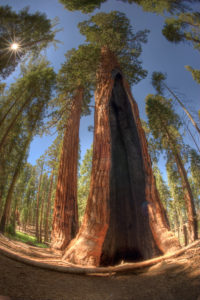
Wildfires
Giant sequoias survive repeated wildfires protected by their bark, which is 3′ thick at the base of large trees. Coastal redwoods can generate new shoots from damaged bark, while only young giant sequoias—younger than 20 years—can recover in this manner. These are pioneer trees, which readily repopulate areas devastated by fire.
The Castle Fire in 2020 and subsequent fires the next year destroyed over 10,000 trees larger than 4′ DBH, about 10-14% of the population in the range. Wildfires help clear the ground of gathering debris and competing growth. The heat helps open the cones, which then disperse their seeds on mineral-rich soil. Fire also eliminates competition from white fir and allows more sunlight to reach the forest floor.
It usually isn’t the fire itself that kills large trees, but rather the accumulated structural damage. When the base of the trunk becomes hollowed out by recurring fires (photo, above), it can no longer support the massive tree.
Controlled, or prescribed, burns limit the accumulation of forest floor debris, enabling growth of successive younger generations of the redwoods. Where needles and leaf litter build up and when undergrowth crowds out the seedlings, fewer young redwoods grow. Forests managed with controlled burns experience less catastrophic fires when they do occur. Black scars burned into their trunks and the trees’ attempt to compartmentalize the damage indicate the resilience of plants on a grand scale.
While visiting my sister in California years ago, our families made a trip to Yosemite National Park. It’s difficult to comprehend the magnificence of these giant sequoias without being in their presence. A must-see. Totally awesome.
* * * * * * *
The resilience of plants affords them the ability to withstand adverse conditions in their environment and to keep the species alive. From the very young to the very old, plants employ various mechanisms to adapt to their environment, increasing their chances of survival.
Headings
Page 1: The Resilience of Plants: Confined Spaces (Drimiopsis Maculata, Classification Confusion, Binomial Nomenclature, Swiss Chard, Agave, The Old Orchid, Bonsai)
Page 2: The Resilience of Plants: Opportunity (A Plant In a Strange Place, Young Lavender, Another Surprise Seedling), The Resilience of Plants: Recovery (Cryptanthus, Propagating Bromeliads, The Petunia, Giant Redwoods Define the Resilience of Plants, Wildfires)

